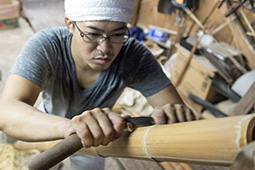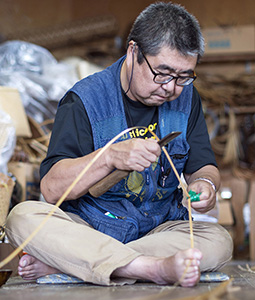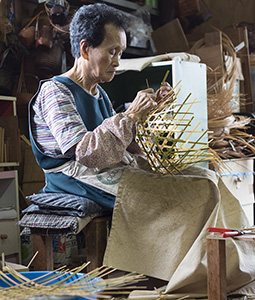Home > Highlighting JAPAN > Highlighting Japan October 2016 > Traditional Crafts
Highlighting JAPAN


The Old Bamboo
The spa resort of Beppu in Oita Prefecture is home to one of Japan’s last remaining bamboo weaving communities.
Sitting on the floor of his two-story workshop, Ichiro Iwao uses a knife to make a vertical slit in the tip of a 1.5-meter strip of bamboo and expertly divides the slightly dampened wood lengthways using his teeth, thumb and forefinger, the trailing end tightly clamped between his big and second toes. In a few seconds he has produced two 0.4 mm-thick lengths of bamboo, which are passed on to his wife, Yoshie, and her coworker, Satsuki Taniwaki, who deftly weave the pieces into baskets ordered by a company growing matsutake mushrooms.
Downstairs, a fourth member, Shunichi Misawa, is busily stripping bamboo in a process known as kawa-migaki (bark polishing). He explains that the madake (woody) bamboo has already been boiled to remove oils and then dried for several weeks before being cut into manageable lengths and stripped to make the surface smooth. The wood is then delivered upstairs for Iwao and the weavers at Iwao Chikuran in Beppu, Oita Prefecture to work on.
Bamboo products have a long history in Beppu, with an entry in the Nihon shoki, Japan’s second oldest extant historical chronicle, reporting that a chef of the twelfth Emperor Keiko (71–130) used Beppu’s bamboo to make baskets during a visit to the city.
Initially such practical items made from this giant grass were produced by farmers and fishermen to carry and store their produce, and then as Japan ended centuries of seclusion from the outside world in the late 1800s, the bamboo craft industry began to grow, according to Iwao.
This was particularly true for Beppu, a city that flourished as a spa resort from around the 1870s. Ably supported by tourism entrepreneur Aburaya Kumahachi, visitors made their way in droves via a new train line and shipping routes from Osaka to soak in the soothing waters of Beppu Onsen. The city soon underwent a construction boom, but with few joiners able to meet the demand for quality ryokan inns, a technical college was opened at the turn of the twentieth century, with a large department devoted to the teaching of bamboo carpentry and craft making.
“Among the items required at the inns were quality bamboo vases for tokonoma alcoves and small writing desks, as well as baskets for storing rice and other commodities,” explains Hiroyuki Minamoto, curator of the Beppu Traditional Bamboo Crafts Center. “Such items became emblematic of so-called shitsurai — the welcoming ambience of the ryokan.”
Soon, demand for bamboo products as souvenirs grew, he adds, spawning an important industry for the city. Consequently, the number of bamboo craftsmen in the city increased, and Iwao Chikuran, which was established by Ichiro’s grandfather in 1919, was among the earliest workshops in operation, at one time boasting a team of twenty, Iwao says.
As a child, Ichiro helped out with the family business, counting bamboo strips or holding bamboo pieces as they were “polished.” As a teenager, he studied at the Oita Bamboo Technical Training Support Center, an offshoot of the original college.
“My father told me this job is tough, but once I started, I never looked back,” says Iwao.
While the industry has shrunk dramatically over the past three decades and the number of communities around Japan practicing the once popular art of bamboo weaving now total just three, Iwao says there is no sign of it dying out. Students from around Japan come to Oita to study the art at the local technical college, while local residents participate in classes at in the Beppu Traditional Bamboo Crafts Center.
“Some graduates go on to become full-time craftsmen,” says instructor Kenichi Otani. “Bamboo is deeply engrained in the local people’s psyche.”
© 2009 Cabinet Office, Government of Japan











